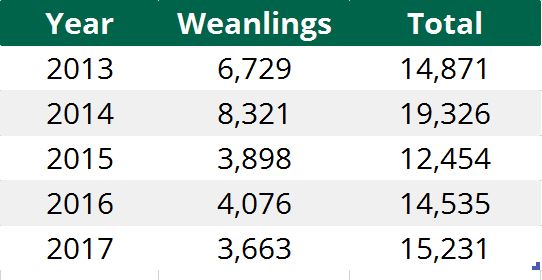Weanling exports to Italy, seen by many as the home of the €1,000 weanling, have dropped to a five-year low, figures from Bord Bia show.
Traditionally, Italian buyers were keen to purchase muscled-type weanlings and were willing to pay market-leading prices to secure such animals. However, demand from Italy has weaned somewhat in recent years.
Up to the week ending August 14, some 3,663 Irish weanlings had been shipped to Italian feedlots – that’s a drop of 4,658 head or 56% compared to the corresponding period in 2014.
Despite this, there has actually been an increase in the total number of Irish cattle that have been shipped to Italian market this year.
In total, some 15,231 cattle have left Irish shores for Italy – an increase of 696 head compared to the corresponding period in 2016.
This comes as there has been a sharp rise in the number of Irish calf exports to the Mediterranean state. Some 6,782 calves have been exported to Italy this year – a jump of 1,599 head compared to the same time in 2016.
Why are weanling exports declining?
French exports to Turkey, which previously stood at 120,000 cattle, were significantly restricted due to persistent outbreaks of Bluetongue this year.
This resulted in a greater French focus on the Italian market and, as a result, French exporters were able to supply weanlings onto the Italian market very competitively.
This, in turn, led to a fall off in the number of cattle being imported into Italy from many other countries such as the Republic of Ireland.
Future potential
Despite the decline in Irish weanling exports to Turkey, the market may well prove a valuable outlet for Irish cattle in the coming years.
Co-op Italia is thought to be keen on importing more weanlings from Ireland to meet its requirement for GM-free and antibiotic-free beef.
Traditionally, the co-op imports 200,000 cattle from France on an annual basis. A further 5,000 Irish weanlings are thought to be imported each year.
However, it now appears the the co-op is keen on importing an additional 50,000 weanlings in the near future. Irish cattle may be ideally positioned to fill the gap in this market due to low quantity of antibiotics and GM feeds being used on Irish farms.

